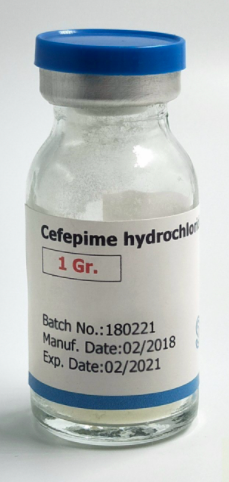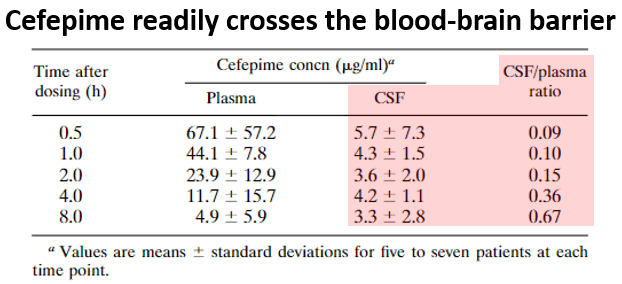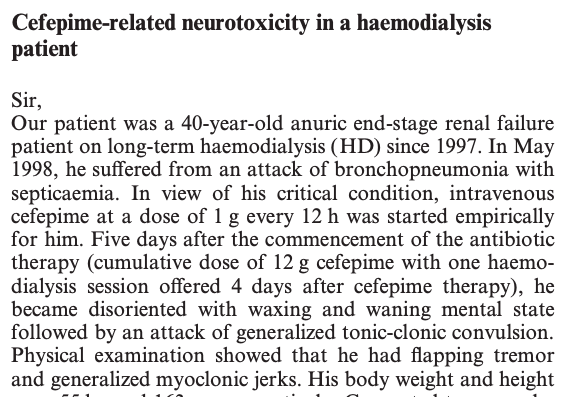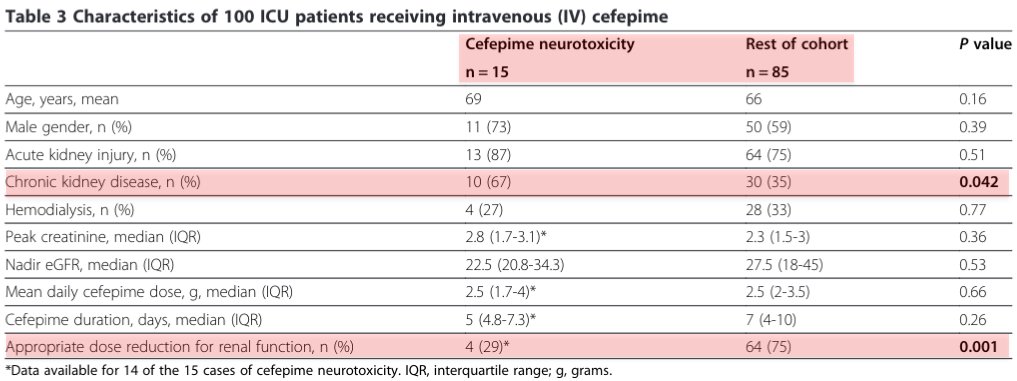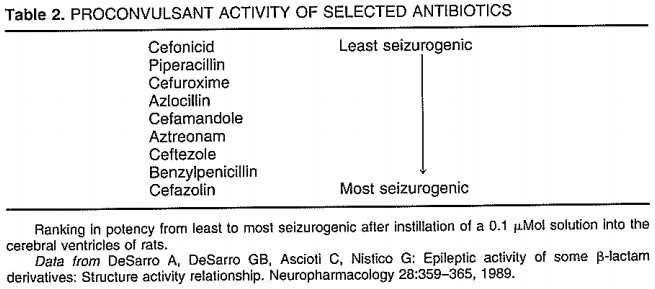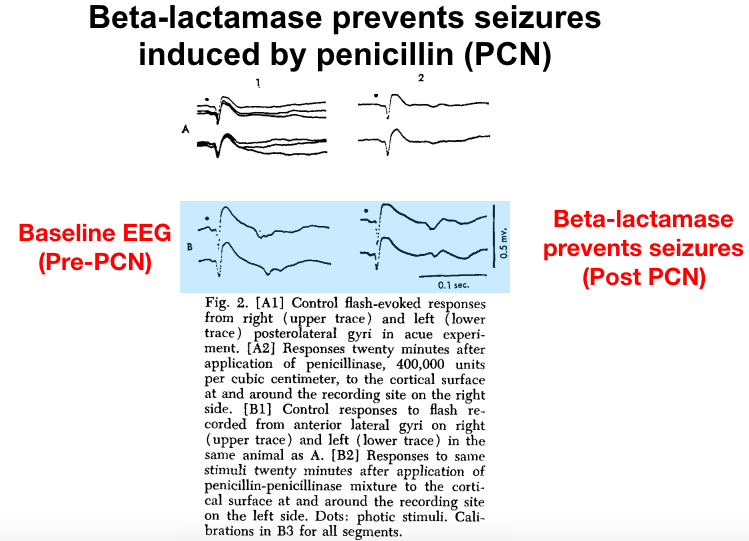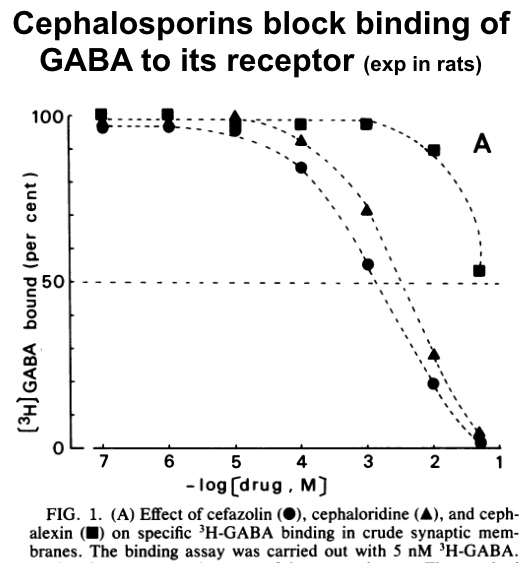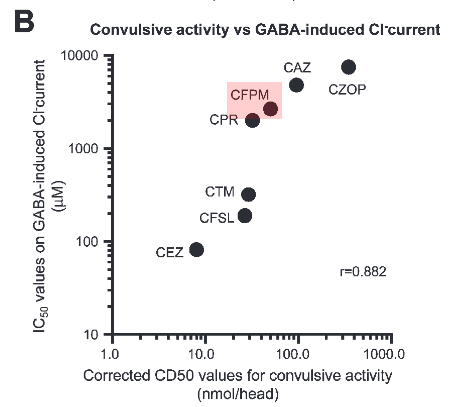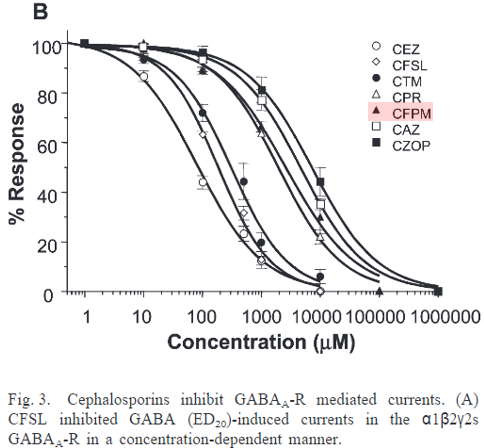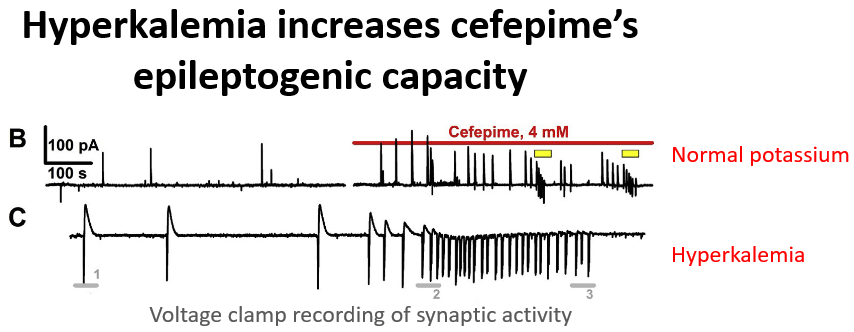1/15
Why can cefepime cause neurological toxicity?
And why is renal failure the main risk factor for this complication?
The answer requires us to learn about cefepime's structure and why it unexpectedly binds to a certain CNS receptor.
#MedTwitter #Tweetorial
Why can cefepime cause neurological toxicity?
And why is renal failure the main risk factor for this complication?
The answer requires us to learn about cefepime's structure and why it unexpectedly binds to a certain CNS receptor.
#MedTwitter #Tweetorial
2/
Let's establish a few facts about cefepime:
 4th generation cephalosporin antibiotic
4th generation cephalosporin antibiotic
 Excretion = exclusively in the urine (mostly as unchanged drug)
Excretion = exclusively in the urine (mostly as unchanged drug)
 Readily crosses the blood-brain barrier (so it easily accesses the brain)
Readily crosses the blood-brain barrier (so it easily accesses the brain)
https://pubmed.ncbi.nlm.nih.gov/7785999/
Let's establish a few facts about cefepime:
 4th generation cephalosporin antibiotic
4th generation cephalosporin antibiotic Excretion = exclusively in the urine (mostly as unchanged drug)
Excretion = exclusively in the urine (mostly as unchanged drug) Readily crosses the blood-brain barrier (so it easily accesses the brain)
Readily crosses the blood-brain barrier (so it easily accesses the brain)https://pubmed.ncbi.nlm.nih.gov/7785999/
3/
The first report of cefepime neurotoxicity was in 1999.
A patient w/ renal failure received high doses of cefepime and then developed encephalopathy, tremors, myoclonic jerks, and tonic-clonic seizures.
 All symptoms resolved after hemodialysis.
All symptoms resolved after hemodialysis.
https://pubmed.ncbi.nlm.nih.gov/10489256/
The first report of cefepime neurotoxicity was in 1999.
A patient w/ renal failure received high doses of cefepime and then developed encephalopathy, tremors, myoclonic jerks, and tonic-clonic seizures.
 All symptoms resolved after hemodialysis.
All symptoms resolved after hemodialysis.https://pubmed.ncbi.nlm.nih.gov/10489256/
4/
Cefepime neurotoxicity is surprisingly common, occurring in up to 15% of treated critically ill patients (w/ symptoms varying from encephalopathy to seizures).
 The main risk factors = renal failure and lack of dose adjustment for renal function.
The main risk factors = renal failure and lack of dose adjustment for renal function.
https://pubmed.ncbi.nlm.nih.gov/24200036/
Cefepime neurotoxicity is surprisingly common, occurring in up to 15% of treated critically ill patients (w/ symptoms varying from encephalopathy to seizures).
 The main risk factors = renal failure and lack of dose adjustment for renal function.
The main risk factors = renal failure and lack of dose adjustment for renal function. https://pubmed.ncbi.nlm.nih.gov/24200036/
5/
What about cefepime induces neurotoxicity?
One clue is that it's not the only antibiotic that causes neurotoxicity, particularly seizures.
This actually is a class effect w/ other beta-lactam antibiotics (including penicillins and carbapenems).
https://pubmed.ncbi.nlm.nih.gov/9330839/
What about cefepime induces neurotoxicity?
One clue is that it's not the only antibiotic that causes neurotoxicity, particularly seizures.
This actually is a class effect w/ other beta-lactam antibiotics (including penicillins and carbapenems).
https://pubmed.ncbi.nlm.nih.gov/9330839/
6/
Recall that beta-lactam antibiotics all share a common structural feature: a beta-lactam ring.
https://pubmed.ncbi.nlm.nih.gov/18676578/
Recall that beta-lactam antibiotics all share a common structural feature: a beta-lactam ring.
https://pubmed.ncbi.nlm.nih.gov/18676578/
7/
A 1971 study in cats implicated beta-lactam rings as the source of neurotoxicity.
High doses of penicillin were used to induce seizures.
 But pre-incubation w/ the enzyme beta-lactamase (disrupts the beta-lactam ring) blocked all seizure activity.
But pre-incubation w/ the enzyme beta-lactamase (disrupts the beta-lactam ring) blocked all seizure activity.
https://pubmed.ncbi.nlm.nih.gov/5105512/
A 1971 study in cats implicated beta-lactam rings as the source of neurotoxicity.
High doses of penicillin were used to induce seizures.
 But pre-incubation w/ the enzyme beta-lactamase (disrupts the beta-lactam ring) blocked all seizure activity.
But pre-incubation w/ the enzyme beta-lactamase (disrupts the beta-lactam ring) blocked all seizure activity.https://pubmed.ncbi.nlm.nih.gov/5105512/
8/
So why can beta-lactam antibiotics like cefepime cause neurotoxicity?
It turns that they block the binding of the inhibitory neurotransmitter gamma aminobutyric acid (GABA) to its receptor.
 Cephalosporins block GABA particularly effectively.
Cephalosporins block GABA particularly effectively.
https://pubmed.ncbi.nlm.nih.gov/2988433/
So why can beta-lactam antibiotics like cefepime cause neurotoxicity?
It turns that they block the binding of the inhibitory neurotransmitter gamma aminobutyric acid (GABA) to its receptor.
 Cephalosporins block GABA particularly effectively.
Cephalosporins block GABA particularly effectively.https://pubmed.ncbi.nlm.nih.gov/2988433/
9/
The GABA receptor has two subtypes (A and B), and the A subtype functions as a ligand-gated Cl⁻ ion channel.
Cefepime binds to the GABA-A receptor and blocks Cl⁻ influx, which correlates with its ability to induce seizure activity.
https://pubmed.ncbi.nlm.nih.gov/12871648/
The GABA receptor has two subtypes (A and B), and the A subtype functions as a ligand-gated Cl⁻ ion channel.
Cefepime binds to the GABA-A receptor and blocks Cl⁻ influx, which correlates with its ability to induce seizure activity.
https://pubmed.ncbi.nlm.nih.gov/12871648/
10/
We've established that cefepime blocks GABA.
This induces neuro-excitation leading to seizures and other neurotoxic manifestations such as tremors and encephalopathy.
 But why is there such a strong link with renal failure?
But why is there such a strong link with renal failure?
We've established that cefepime blocks GABA.
This induces neuro-excitation leading to seizures and other neurotoxic manifestations such as tremors and encephalopathy.
 But why is there such a strong link with renal failure?
But why is there such a strong link with renal failure?
11/
An obvious explanation would be that, since cefepime is renally cleared, elevated serum and CNS drug levels build up.
This is supported by the observation that cefepime and other cephalosporins block GABA in a concentration-dependent manner.
https://pubmed.ncbi.nlm.nih.gov/12871648/
An obvious explanation would be that, since cefepime is renally cleared, elevated serum and CNS drug levels build up.
This is supported by the observation that cefepime and other cephalosporins block GABA in a concentration-dependent manner.
https://pubmed.ncbi.nlm.nih.gov/12871648/
12/
But increased drug levels might not be the only reason that patients w/ renal failure are predisposed to neurotoxicity.
The milieu around neurons seems to matter as well.
But increased drug levels might not be the only reason that patients w/ renal failure are predisposed to neurotoxicity.
The milieu around neurons seems to matter as well.
13/
This experiment in rat brain slices simulated a "renal" milieu by using a hyperkalemic medium around neurons.
 Exposure to higher potassium levels significantly increased the ability of cefepime to induce epileptiform discharges.
Exposure to higher potassium levels significantly increased the ability of cefepime to induce epileptiform discharges.
https://pubmed.ncbi.nlm.nih.gov/29625107/
This experiment in rat brain slices simulated a "renal" milieu by using a hyperkalemic medium around neurons.
 Exposure to higher potassium levels significantly increased the ability of cefepime to induce epileptiform discharges.
Exposure to higher potassium levels significantly increased the ability of cefepime to induce epileptiform discharges.https://pubmed.ncbi.nlm.nih.gov/29625107/
14/
Let's ask one final question.
Why can cefepime (and other beta-lactam antibiotics) block the GABA receptor?
Exactly why hasn't been well-studied but it likely reflects sufficient structural similarity w/ GABA.
https://pubmed.ncbi.nlm.nih.gov/16261307/
Let's ask one final question.
Why can cefepime (and other beta-lactam antibiotics) block the GABA receptor?
Exactly why hasn't been well-studied but it likely reflects sufficient structural similarity w/ GABA.
https://pubmed.ncbi.nlm.nih.gov/16261307/
15/
 Cefepime induces neurotoxicity by blocking the GABA receptor, similar to other beta-lactam antibiotics
Cefepime induces neurotoxicity by blocking the GABA receptor, similar to other beta-lactam antibiotics
 This results from structural similarities between GABA and the beta-lactam ring
This results from structural similarities between GABA and the beta-lactam ring
 Renal failure = main risk factor b/c of
Renal failure = main risk factor b/c of  drug levels +/- hyperkalemia
drug levels +/- hyperkalemia
 Cefepime induces neurotoxicity by blocking the GABA receptor, similar to other beta-lactam antibiotics
Cefepime induces neurotoxicity by blocking the GABA receptor, similar to other beta-lactam antibiotics This results from structural similarities between GABA and the beta-lactam ring
This results from structural similarities between GABA and the beta-lactam ring Renal failure = main risk factor b/c of
Renal failure = main risk factor b/c of  drug levels +/- hyperkalemia
drug levels +/- hyperkalemia

 Read on Twitter
Read on Twitter